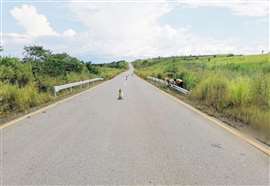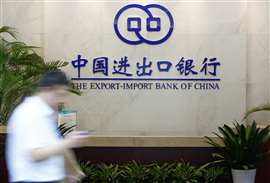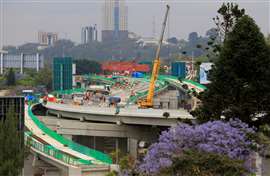Why African countries are being urged to rethink loans for new infrastructure to avoid ‘disaster’
17 October 2023
 A view of the Quitexe-Ambuila highway in Angola’s Uige province, which is built by China Railway No.4 Engineering Group Co (Image: Xinhua Silk Road via Cision PR Newswire)
A view of the Quitexe-Ambuila highway in Angola’s Uige province, which is built by China Railway No.4 Engineering Group Co (Image: Xinhua Silk Road via Cision PR Newswire)
Loans that demand natural resources in return for money to fund infrastructure and construction projects are a “disaster” for Africa and countries on the continent should stop taking them.
That is the message from the International Monetary Fund (IMF) and African Development Bank (AfDB), which have warned that such loans risk pushing countries into a debt trap.
The warning came after a meeting between IMF managing director Kristalina Georgieva and AfDB president Dr Akinwumi Adesina in Abdijan, Côte D’Ivoire.
Adesina said, “The natural resource-backed loans are non-transparent, expensive and make debt resolution difficult” and cautioned that if the trend continued “it will be a disaster for Africa”.
The AfDB did not elaborate on where such loans originate or which particular African countries have been tempted to take them.
However, it is well known that China has favoured the controversial resource-backed infrastructure financing model in the past and that China’s approach to infrastructure financing has made it harder for construction contractors from other parts of the world to compete in Africa against their state-owned Chinese competitors.
Resource-secured lending accounted for 26% of all Chinese loans in African from 2000 to 2019 and one country in particular – Angola – took advantage of that model with oil-secured loans to build new roads and bridges across the country following its long-running civil war. The Angolan government decided to stop taking new loans of that type several years ago, reflecting concerns from the IMF.
But despite the IMF’s concerns, other countries like Ghana and Guinea have continued to use resource-backed loans. A 2021 study by Johns Hopkins School of Advanced International Studies (SAIS) noted that even though Chinese lending through the Belt and Road Initiative (BRI) is falling amid concerns over debt sustainability, “the controversial resource-backed infrastructure model is not dead”.
 A man walks past the lobby of the Export-Import Bank of China (EXIM) headquarters in Beijing (Image: Reuters)
A man walks past the lobby of the Export-Import Bank of China (EXIM) headquarters in Beijing (Image: Reuters)
Separately, western contractors have previously expressed concerns about the funding models that China uses, arguing that it makes them uncompetitive against their Chinese counterparts.
The construction industry body European International Contractors (EIC) has warned that China “remains reluctant to adhere to the global financial architecture and its regulations” and that China’s willingness to lend has benefited construction contractors owned by Chinese state, who have been able to undercut competitors by up to 20% to secure contracts.
Frank Kehlenbach, director of European International Contractors told International Construction: “EIC observes that resource-backed loans from the Chinese government for infrastructure projects are part of China’s officially supported financing programme and provide Chinese state-owned enterprises with an unfair competitive advantage, as European contractors cannot offer similar funding opportunities outside of the multilateral financial framework.
“Given the complete lack of transparency, these financing practices are not only a threat to debt sustainability of individual developing countries, but also a serious threat to the integrity of the IMF/ WB Debt Sustainability Framework for low-income countries, to the OECD ‘Paris Club’, to the ‘preferred creditor status’ of IMF and relevant Multilateral Development Banks and sustainable lending principles of the OECD Export Credit Agencies.”
Channeling more funding into Africa
On her way to Marrakech in Morocco for the first World Bank Group and IMF annual meetings to be held in Africa for 50 years, the IMF’s Georgieva said the continent’s young population made it ripe for economic growth.
But she warned, “Unless we build a bridge for capital to flow to where it is needed most, it could lead to a bigger problem.”
AfDB’s Adesina said he hoped that Africa could eventually get more access to some of the $650 billion in Special Drawing Rights (SDRs) originally set up by the IMF Chief and US Secretary of Treasury Janet Yellen to shore up the global economy amid the Covid-19 pandemic in 2021.
Africa received about $33 billion in SDRs, which was only 5% of the total allocation – the smallest portion among different regions of the world.
The AfDB said it was working to develop models that would allow SDRs to be rechanneled through multilateral development banks. MDBs can leverage such resources to three to four times their original values.
Adesina said, “Together with the Inter-American Development Bank we developed a model that meets the IMF’s reserve asset status. If you channel $5 billion through the Bank, we will use our leveraging power and that could easily become $20 billion of new financing for Africa.”
The proposal has the backing of Africa leaders as well as UN Secretary General António Guterres, the AfDB claimed.
Georgieva added, “I’m on record supporting the Bank’s effort and if this succeeds, there will be a significant expansion of financial capacity for countries even beyond our years in office.”
Is China’s funding model evolving anyway?
 Workers are seen on site during the construction of the Nairobi Expressway, undertaken by the China Road and Bridge Corporation (CRBC) on a public-private partnership (PPP) basis, along Uhuru Highway in Nairobi (Image: Reuters/Thomas Mukoya)
Workers are seen on site during the construction of the Nairobi Expressway, undertaken by the China Road and Bridge Corporation (CRBC) on a public-private partnership (PPP) basis, along Uhuru Highway in Nairobi (Image: Reuters/Thomas Mukoya)
China’s lending to African countries hit a peak in 2016, shortly after the launch of the Belt and Road Initiative.
But since then, lending by China to African countries has fallen significantly.
A report which emerged earlier this year, by the Green Finance & Development Centre (GFDC), part of the Fanhai International School of Finance in Shanghai, noted a “significant slump” in Chinese BRI engagement in sub-Saharan African countries in 2022.
And data from Boston University’s Global China Initiative released last month showed that Chinese sovereign lending to Africa dropped below $1 billion last year – the lowest level for two decades – as Beijing shifts away from funding major infrastructure projects on the continent.
In addition to China’s own economic headwinds, the drop in funding is likely to have been driven by China’s lower appetite for risk amid fears that some countries have been struggling to pay what they owe.
A study by AidData and World Bank published earlier this year noted that the scale of China’s global bailout lending programme has grown rapidly, largely behind the scenes.
It found that China has extended more than US$185 billion USD in the past five years alone (2016-2021) to countries struggling with debt. Almost all Chinese loans have gone to low- and middle-income BRI countries with significant outstanding debts to Chinese banks.
And in January this year, Uganda cancelled a US$2.3 billion deal with China Harbour Engineering to build a major new railway line linking Kampala and Uganda’s border with Kenya. The move came after Beijing decided not to fund the 273km line via its Export-Import Bank amid concerns about its financial viability.
China has also developed new models of financing, as alternatives to the resource-backed model. In Kenya, for example, the new Nairobi expressway was built under a US$600 million ‘build-operate-transfer’ deal, which sees China Road and Bridge Corporation operate the road for a 30-year period before ownership transfers back to Kenya’s government.
STAY CONNECTED



Receive the information you need when you need it through our world-leading magazines, newsletters and daily briefings.
CONNECT WITH THE TEAM








